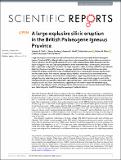Files in this item
A large explosive silicic eruption in the British Palaeogene Igneous Province
Item metadata
| dc.contributor.author | Troll, Valentin R | |
| dc.contributor.author | Emeleus, C Henry | |
| dc.contributor.author | Nicoll, Graeme R | |
| dc.contributor.author | Mattsson, Tobias | |
| dc.contributor.author | Ellam, Robert M | |
| dc.contributor.author | Donaldson, Colin H | |
| dc.contributor.author | Harris, Chris | |
| dc.date.accessioned | 2019-01-30T13:30:05Z | |
| dc.date.available | 2019-01-30T13:30:05Z | |
| dc.date.issued | 2019-01-24 | |
| dc.identifier | 257558443 | |
| dc.identifier | 0fb06f22-3c8f-4fea-8e0a-aa773bf674b3 | |
| dc.identifier | 85060550039 | |
| dc.identifier | 000456553400060 | |
| dc.identifier | 30679443 | |
| dc.identifier.citation | Troll , V R , Emeleus , C H , Nicoll , G R , Mattsson , T , Ellam , R M , Donaldson , C H & Harris , C 2019 , ' A large explosive silicic eruption in the British Palaeogene Igneous Province ' , Scientific Reports , vol. 9 , 494 . https://doi.org/10.1038/s41598-018-35855-w | en |
| dc.identifier.issn | 2045-2322 | |
| dc.identifier.other | RIS: urn:D4017C371B988EDE500D07D9C0A80082 | |
| dc.identifier.other | RIS: Troll2019 | |
| dc.identifier.other | PubMedCentral: PMC6345756 | |
| dc.identifier.other | ORCID: /0000-0003-0717-4014/work/84315519 | |
| dc.identifier.uri | https://hdl.handle.net/10023/16963 | |
| dc.description | Authors are grateful to the Scottish Natural Heritage (SNH), Science Foundation Ireland (SFI), the Royal Irish Academy (RIA), and the Swedish Science Foundation (VR) for logistical and financial support. | en |
| dc.description.abstract | Large-volume pyroclastic eruptions are not known from the basalt-dominated British Palaeogene Igneous Province (BPIP), although silicic magmatism is documented from intra-caldera successions in central volcanoes and from small-volume ash-layers in the associated lava fields. Exceptions are the Sgùrr of Eigg (58.7 Ma) and Òigh-sgeir pitchstones in the Inner Hebrides (>30 km apart), which have been conjectured to represent remnants of a single large silicic event. Currently available major element data from these outcrops differ, however, creating a need to test if the two pitchstones are really related. We employ a systematic array of methods ranging from mineralogy to isotope geochemistry and find that samples from the two outcrops display identical mineral textures and compositions, major- and trace elements, and Sr-Nd-Pb-O isotope ratios, supporting that the two outcrops represent a single, formerly extensive, pyroclastic deposit. Available isotope constraints suggest a vent in the Hebridean Terrane and available radiometric ages point to Skye, ~40 km to the North. A reconstructed eruption volume of ≥5km3 DRE is derived, suggesting a VEI 5 event or larger. We therefore argue, contrary to long-held perception, that large-volume silicic volcanism and its associated climatic effects were likely integral to the BPIP during the opening of the North Atlantic. | |
| dc.format.extent | 15 | |
| dc.format.extent | 5219214 | |
| dc.language.iso | eng | |
| dc.relation.ispartof | Scientific Reports | en |
| dc.subject | GE Environmental Sciences | en |
| dc.subject | DAS | en |
| dc.subject.lcc | GE | en |
| dc.title | A large explosive silicic eruption in the British Palaeogene Igneous Province | en |
| dc.type | Journal article | en |
| dc.contributor.institution | University of St Andrews. School of Earth & Environmental Sciences | en |
| dc.contributor.institution | University of St Andrews. Earth and Environmental Sciences | en |
| dc.identifier.doi | 10.1038/s41598-018-35855-w | |
| dc.description.status | Peer reviewed | en |
This item appears in the following Collection(s)
Items in the St Andrews Research Repository are protected by copyright, with all rights reserved, unless otherwise indicated.

